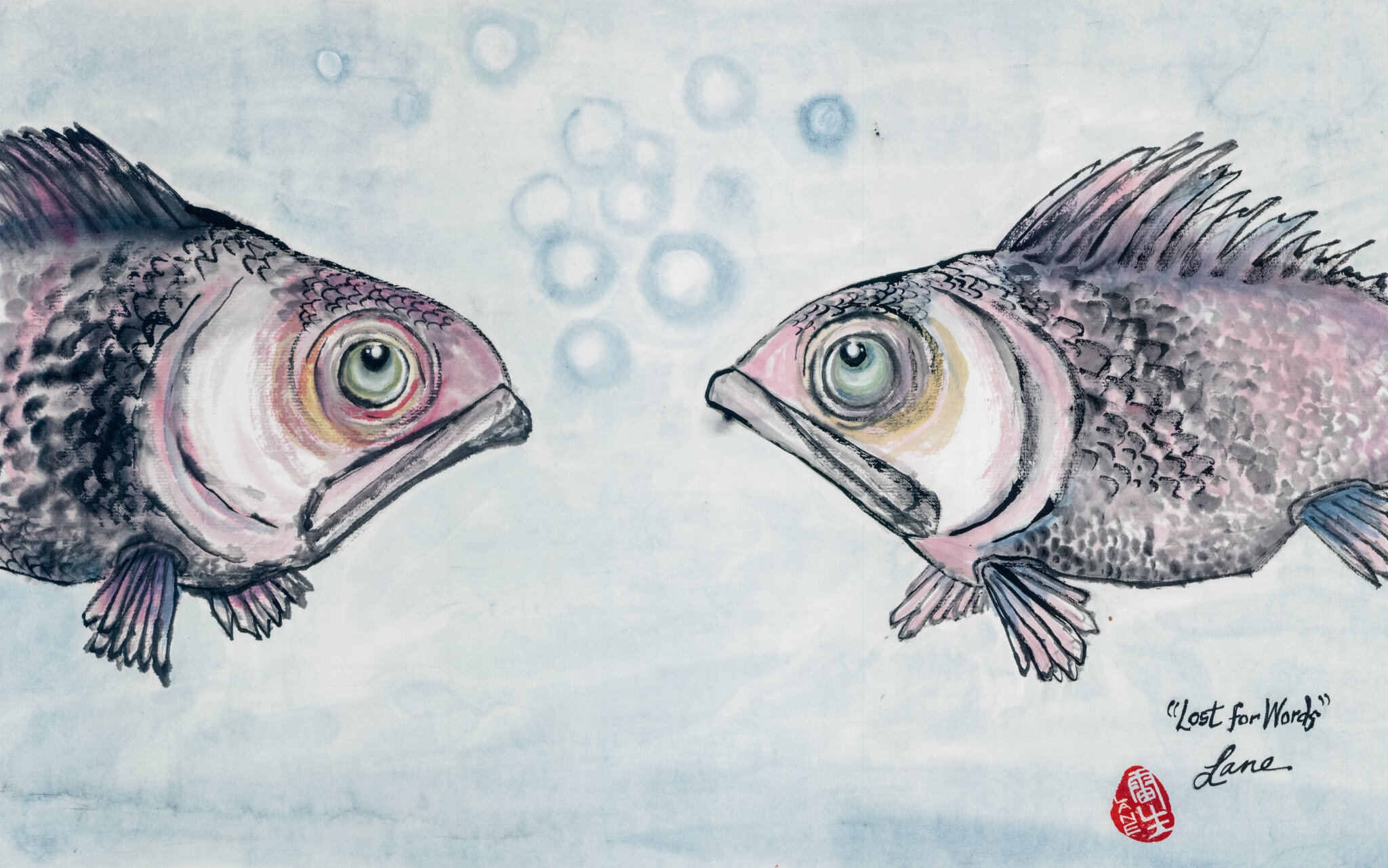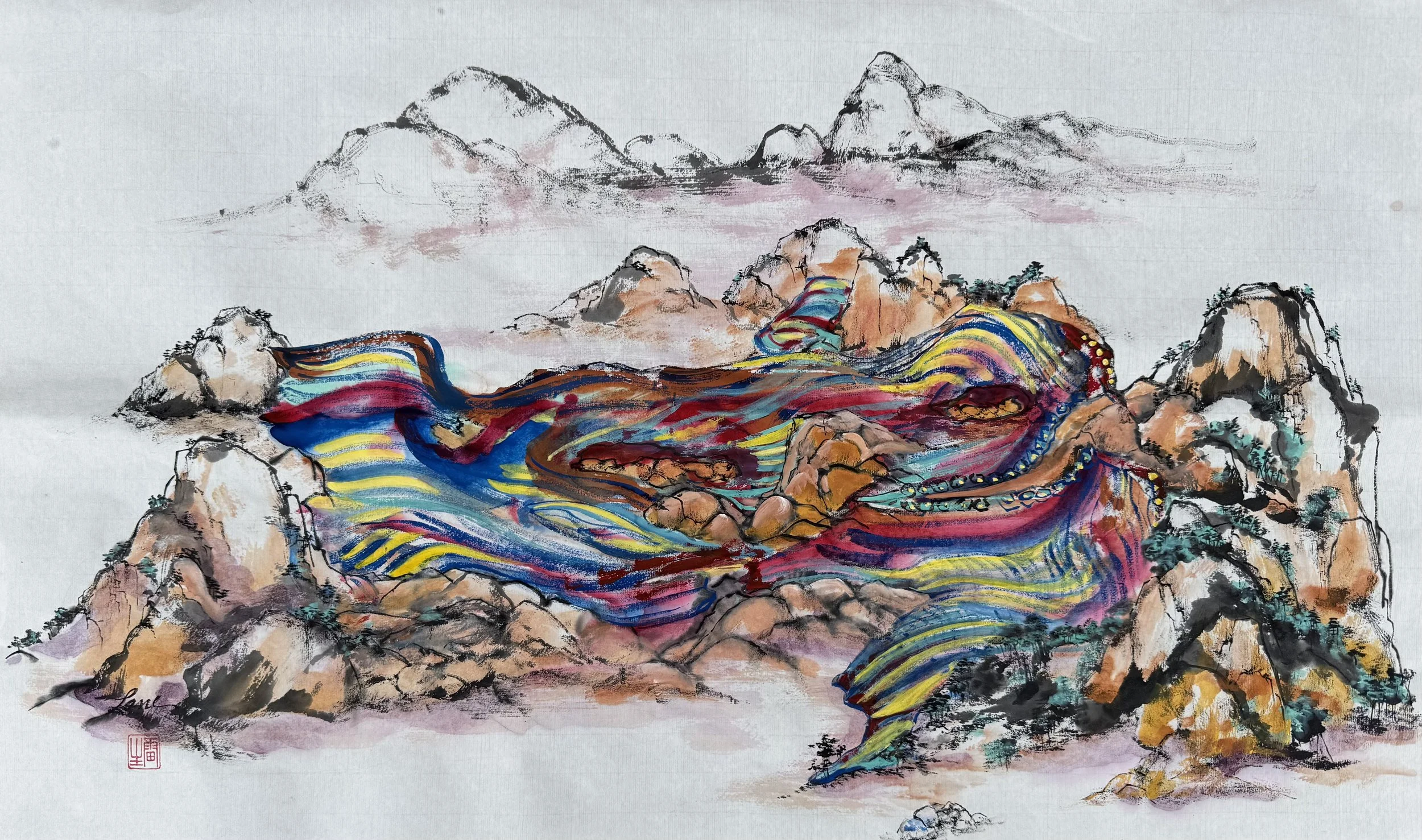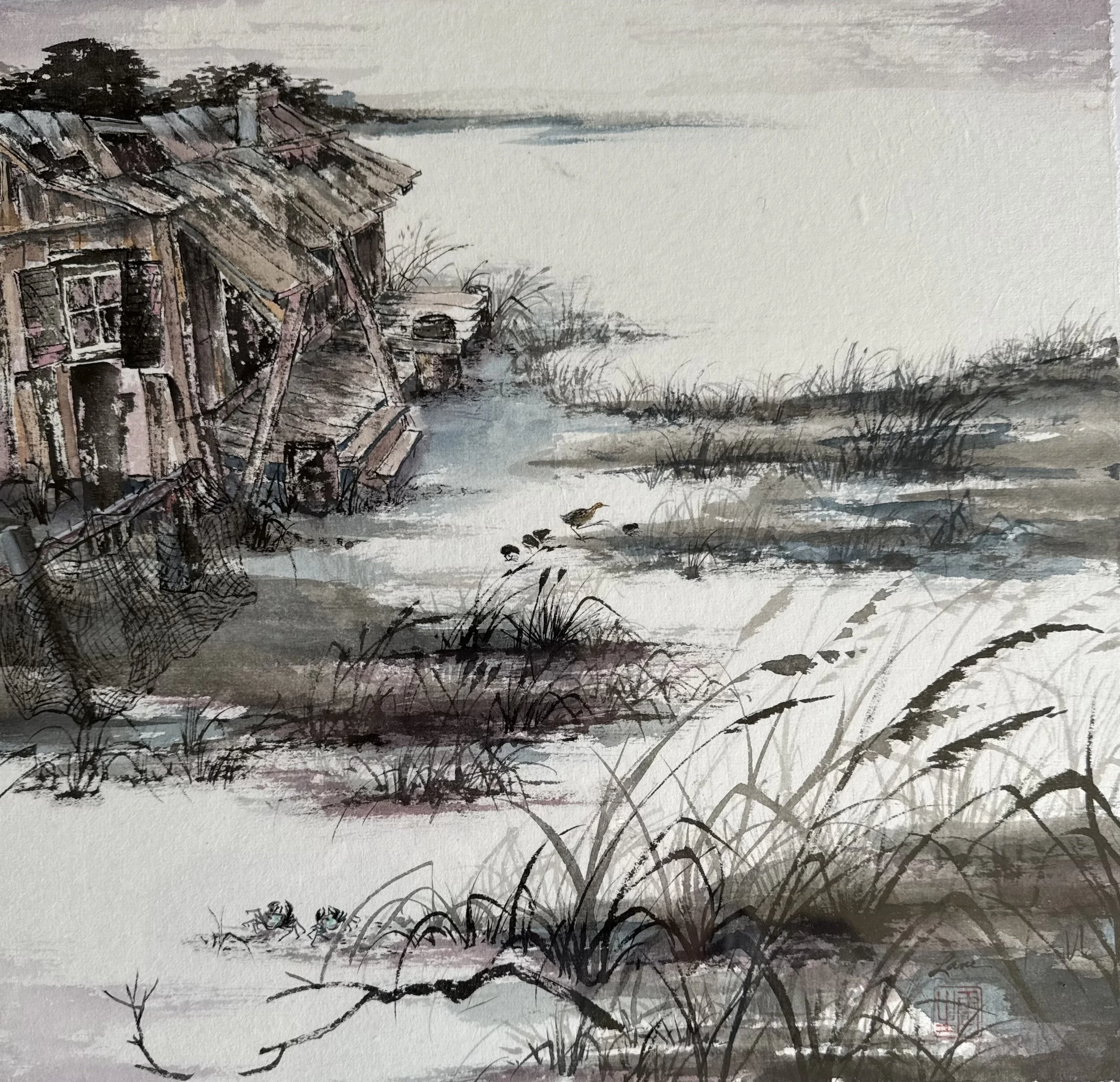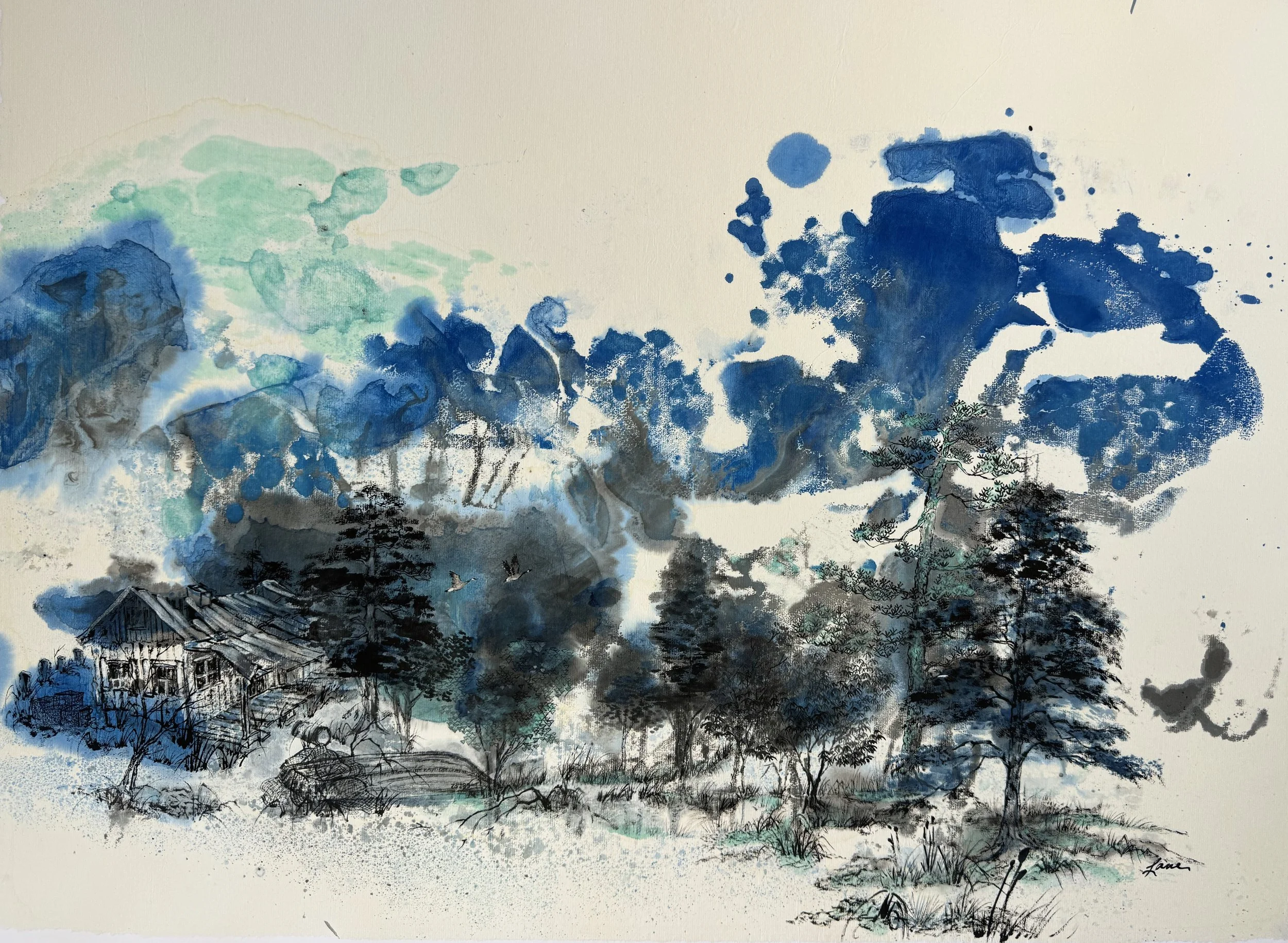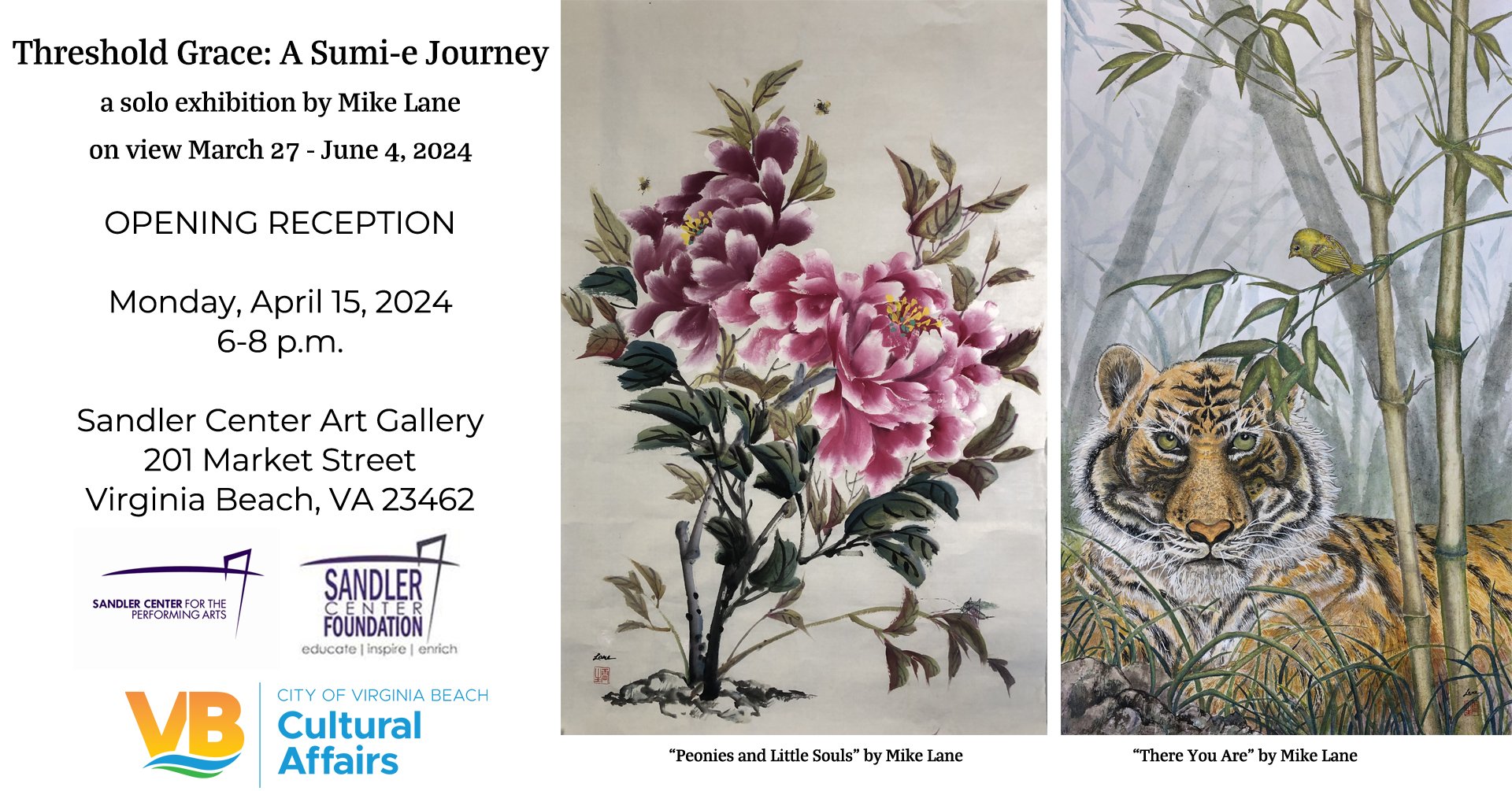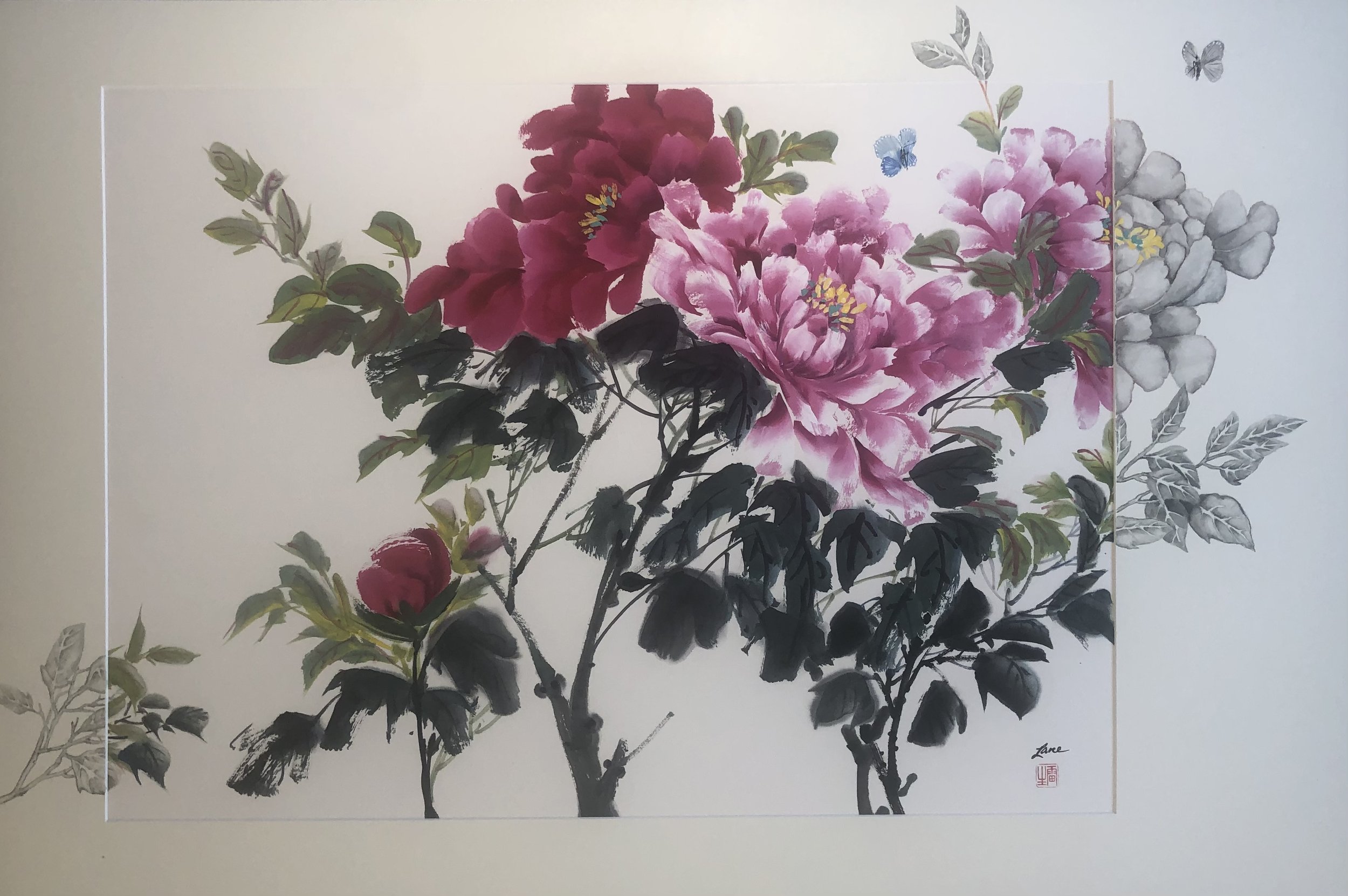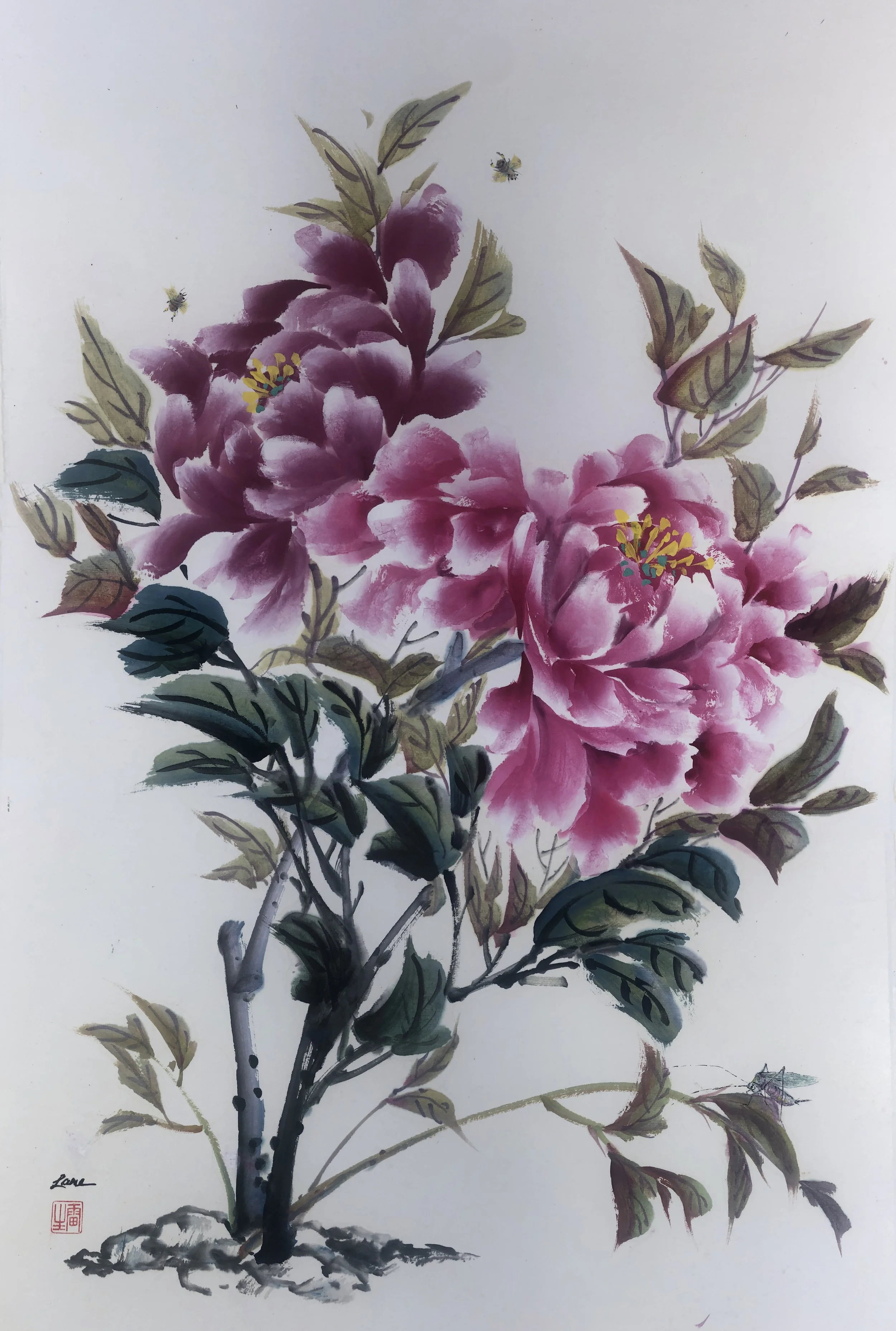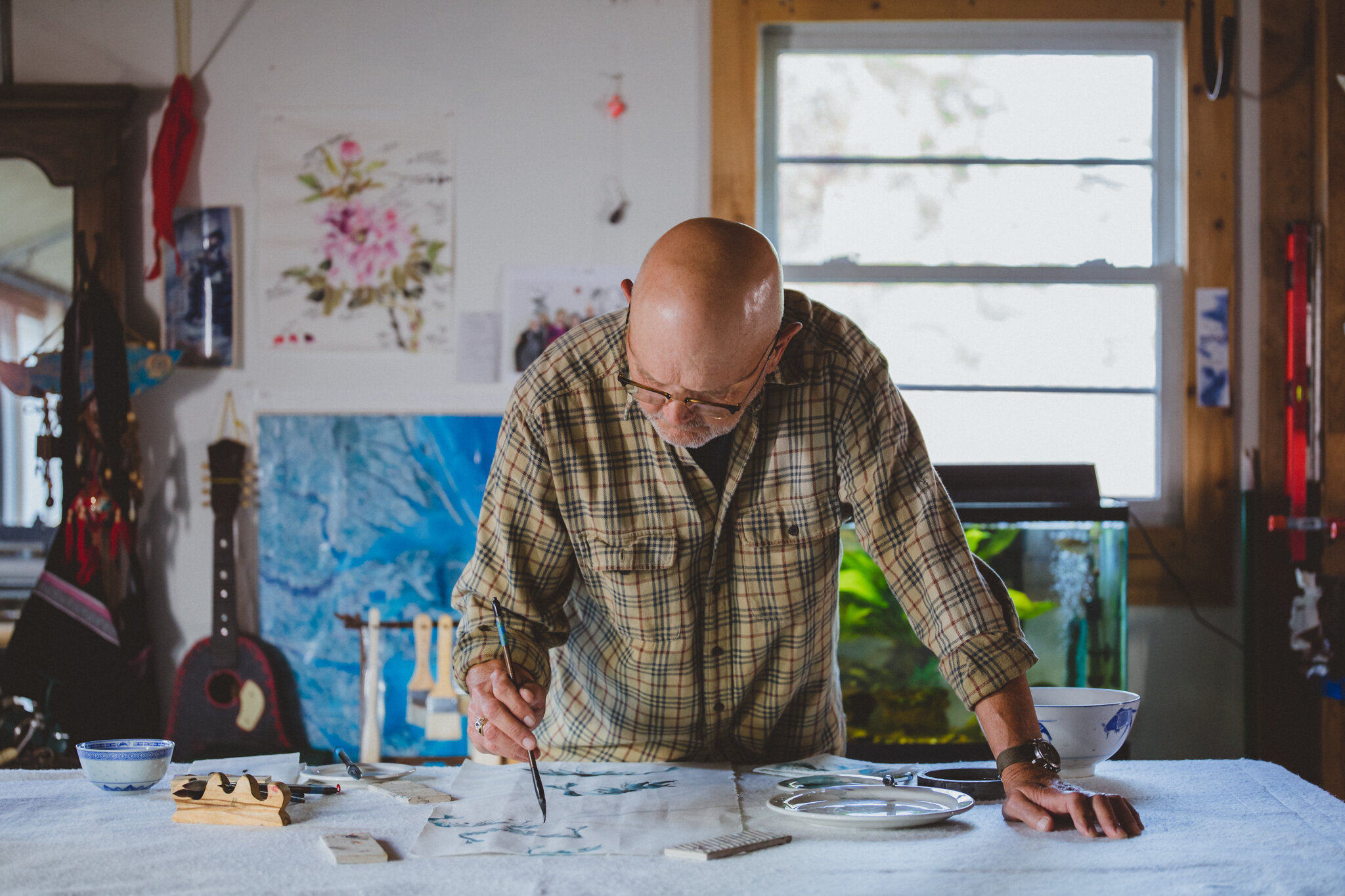
IMAGO DEI
Process… from the solitude of the studio… energized by joy in the design, the designer and the community of artists around me...
Blog : Imago Dei
As with most artists, I love the aloneness of the studio. That said, I have learned to love my art community—understanding local artists, affirming their work, giving and receiving suggestions, and growing as I allow them into my process.
In Asian traditions, spirituality and art share a similar and sometimes overlapping space. The concept of Imago Dei, the belief that mankind’s art naturally unfolds as an imprint of a creator God, motivates and encourages me as I paint. Because he is a maker, human beings make…
“The Winding Road to Retirement”
“The Winding Road to Retirement” is a personal work though it was created as a commission and was immediately shipped out to its home in Ohio. I just sort of started the work in a dispassionate way but was soon drawn in to the layered narrative— an abandoned bulkhead, a broken vessel, tracks of the couple (the crabs) as they ran the gaunlet under the noses (beaks) of the hungry egrets, and then finally the bewildered gaze fo the two “survivors” at the expansive water’s edge…fun stuff.
“White Flower”
“White Flower” is part of an exciting collaboration with classical guitar player, Herb Smith. After Herb recorded short classical pieces for his CD, I Iistened to several selections. His recording of “Bianco Fiore” caught my attention, and I really enjoyed trying to capture its rhythm, runs and trills. I’ll include a link to Herb’s music here in hopes that you’ll be able to take in this "total” experience.
“When Truth Seems in Short Supply”
This painting was created for the Chapel Gallery’s autumn exhibition that focused on the life of the Bibilcal figure, Jacob. The highly metaphorical piece points to the "social landscape" of Jacob and in particular the challenge of deceit and falsehood that seemed to invade his life many times. Despite the lack of truth and the deceiving world around him (Jacob was both a deceiver at times and a victim of deceit), God was in control and working out his grand plan of redemption. At the center of Jacob’s “life-landscape” is Joseph's coat of many colors that his brothers tore and spotted with blood in order to deceive their father, Jacob. This is such a disheartening event; yet in the end, the divine redemptive hand of grace reveals itself as Joseph attests in Gen. 50:20 — “As for you, you meant evil against me, but God meant it for good, to bring it about that many people should be kept alive today.”
“The Last Three Seconds”
As I understand it, the Japanese enso finds its roots in a zen tradition that is an aid to meditation, an expression of enlightenment and a state of mind that is momentary yet profound. As a modern artistic practice, it is also sometimes filled or surrounded by an inscription or scene that hints at the artist’s intended meaning. It meshes well with Chinese “one breath” free style (xieyi) painting and as such, expresses the spontaneity and energy of a moment experienced in the mind of the artist. Recently, I painted ensos as an artistic relaxation exercise, and in the end, discovered several that needed further development with my brush. “The Last Three Seconds” or as I sometimes call it “my hospice piece” (lol), expresses my Christian hope — renewal and eternal life after death. The three consecutive seconds— the first moment, a plum tree blossoming in the final season, its disintigration in the middle second, and its transformation into a luxurious evergreen filling the transition moment. The inscription is the title— the last three seconds.
Bruegel Anyone?
One of the startling themes in the art of Bruegel is human mortality. In many of his works, death comes in the midst of the mundane everyday activities of existence. Perhaps not as dramatic but still startling are the abandoned houses, the homes of fishermen, that stand in ruins on the edge of things. This is a kind of death— the death of a way of life, a testiment to the tidal water of the creeks that rises, invades and evicts… The marsh hen and her brood scamper across in front of the old house. They are looking for mudcrabs and grasshoppers. Life is good. The open door swings open with the wind and the torn and rotting nets still hang next to the collapsing front porch. There is a sad lesson here.
The Winding Path
Retirement is reached after negotiating a winding and risk-ladden path. This piece underscores that fact. The “couple”, the two crabs, have made their way through the labrinth of spartina grass. Predators, the 3 egrets, now seeming to be behind them, wait for their ambush moment, patiently and attentively on the lookout for other travelers.
Is this the final destination— two crabs —reaching the edge of the creek and staring out at the expanse? This is supposed to be a happy moment. Are they confused? Or are they just overwhelmed with the multitude of opportunities up ahead? We are built to run best on meaning. Retirement aside, the demands of questions like “why” and “so what” are crucial all the time, and I find this need and drive for meaning is especially important for artists, each work is a question really— why? and so what?
Marsh Hen: On The Run
I recently arrived at what I call my “marsh studio” in Engelhard, NC, and my neighbor, Louis, pointed out two marsh hens in the front yard. They weren’t in sight long as they quickly scurried into the spartina grass. Louis explained that the marsh hens are specifically known as Virginia rails. He said they come every year and parent a brood of black-downy babies. He said he tells his cats they are off limits….I wonder what his cats are thinking at that moment, but anyway, it was cool to see the pair. According to my brief research, I found the Virginia rails are very shy and secretive birds. They are monogomous and are, if hunted and cooked, pretty tasty. Personally, I am not expecting them to appear on my table, but I am looking forward to seeing the brood running around in a few weeks. The piece I just finished is the first of a series of marsh hen studies I’d like to do this Spring….I am inspired but we’ll see what happens.
The painting below started slow and I nearly discarded it after the first pass with the brush. But then something happened. As the roots of the spartina grass and other marsh vegetation darkened and grew richer, the hen’s orange-brown breast and white trim popped. It is nice when this happens and reminds me of moments when camouflaged and relatively “invisible” creatures suddenly come into focus. Such sudden discoveries suggest I am in need of more mindful attentiveness. The little hen in this piece is a teenager trying out his legs, and he has two companions— the katydid in the upper left and (my favorite) the little ladybug to the right of the bird. The Mattamuskeet lodge smokestack in the upper left corner marks the location.
A Reason For Rain
This piece was personally gratifying to create. The pour simply happened, and then the flow of pigments and ink spoke, and water rushed down. Rain, for me, is often an unwanted guest, but the meandering of the rocky brook provided another take on rain. Rain creates and compels, and it finds a way. I especially enjoyed the small rivulet that emerges from the stand of trees at the lower left suggesting a special and secret spot that quenches thirst and invites meditation. The scene also raises awareness that the droplets and rivulets do find a bigger home in the creek below. There is direction and then rest. The departing heron is, in this case, a watcher who has been filled (with fish?). The abstracted ink and indigo that hosts the scene makes me thankful for clarity and emergent meaning from the Designer…. if I can just patiently wait on Him.
NC Hwy 94
It is my habit to drive NC Hwy 94 on the way to my “marsh studio” in Engelhard, NC. Some stretches of this highway between Columbia and Fairfield seem remote and lonely. Many are extremely straight and when I see no one is visible in front or behind, I stop in the middle of the road long enough to jump out and photograph the yellow pitcher plants, white water lilies, turtles, dragonflies, etc. in the shallow ditch that parallels the blacktop. They are an amazing example of simple NC marsh beauty. I might intentionally drive to a botanical park or a Japanese garden to see such a lovely partnership of flora and fauna, but then, on other days I find myself just cruising to my kayaks and cabin, eating an egg Mcmuffin…thinking about where I can get bait shrimp and then suddenly…there they are. It always surprises…in a wonderful way.
Watched Over
“Bodie Light” is the first in a series of paintings that explore the quiet moments of little living things in the marsh. The piece focuses on two sources of light— the sunrise and the lamp of the Bodie Island lighthouse. Together they open up the marsh landscape and even spotlight an egret and 2 mudflat crabs in the foreground. The attention given to the impact of light across the scene is decidedly an “unsumi-e” gesture, but I took that rather transgressive excursion for a purpose. The painting was created for a special show at my church’s up-and-coming gallery show called — “Bringing the Light.” In the end, to me, the yellow rays give the wet and broken marsh-scape a warm brilliance. The tonal qualities evoke a feeling of peace and a quiet assurance that all things are being watched over.
“Angels & Their Jobs”
The Virginia Beach Chapel Gallery show opens in about one week (running Nov. 1-Jan. 5) and I, for a change, have looked ahead and created a work for the exhibition. The subject matter is traditional— shepherds, sheep, a multitude of angels, star, special star to indicate Jesus’s birthplace, lots of light in the middle of the night. A fun scene. I decided to take the fun to the next level by including a Farsidesque lost sheep in the right foreground, an angel playing a Fender and another playing a Hofner 500 (a “Beatle bass”), one with a sax…and so on. The work is a fusion of Western and Eastern styles. As my son said, “Dad, they don’t have mountains like that near Bethlehem.” Anyway, I enjoyed the indigo/mineral green applications in the piece. As for the fusion and fun, well… I hope they just create a playful invitation to come and have a closer look at a very significant moment in human history.
Decisions…Decisions
Autumn is the time for celebrating the 9th month of the lunar calendar with paintings of chrysanthemums. This is the sumi-e way. Personally, I don’t grow mums in my garden, but I do love the stark frankness of ink as it incisively brings the closing comment to summer and growth and possibility. If embraced, it accents the melancholy of golden years and, as the Japanese say, the “beautiful death” of all finite things. The artistic expression is not sudden, brash or defined by sharp edges. Dying is a process, a process of many unfolding decisions. The two old friends in the tops of the mums- the grasshopper and the katydid— face one another from the two sides of the path. Approaching one another one final time in the cool autumn morning is a possibility that seems appealing, but it is not without danger— the mindless sparrow looking for breakfast is in the way… Decisions…Decisions.
“Waters Rising”
There is a certain “high ground” to artistic grumbling about ecological decay. This is easy to see in the land next to marshes. Ice is melting and the water is, indeed, rising. That said, my personal connect feels strongest to the displaced lives and brokeness of families as they pursue their traditional ways at the edge.
Exhibition 1: “Threshold Grace: A Sumi-e Journey
It is a priviledge to announce my solo show at the Sandler Center that opens at the end of the month. Hope you can come to the reception on April 15th. If you, by chance, just can’t make it on the night of April 15th but would like a guided walk through, just let me know via email (mike@thresholdart.com) and I’ll plan to meet you at the Sandler gallery.
“Abiding at the Edge”
In a rather ironic way, this steam punk-ish rendering of the fiddler mud crab’s claw and the stressed spartina grass points to the failure of mankind’s efforts to fix and mend what industrialization and commercialization of the land has destroyed. Life, in fact , is not better for many of our fellow creatures. Most live on the edge. The old battle worn fiddler crab strikes a noble pose but he is standing on a mudflat where global warming and rising water levels make life uncertain.
“King of the Ditch”
The model for this painting is the drainage ditch that connects my marsh shack property with Middle Creek in Engelhard, NC. Canals, pumps, and ditches dominate this area where rising water levels threaten fields and homes all year round. Humans try to manage things, but as soon as the construction equipment pulls away, the “little souls” move in to mediate and run the place. This ecological theme has been cropping up in my work more than usual recently. In this liminal space, elemental forces seek a new and viable equalibrium between land and water, but this drama is played out on a micro level… on every mudflat.
AI Art or Not?
As I mentioned in the previous post, I recently led a 3-hour workshop about minimalism and in looking for accessible and clear examples of minimalism I came across the work of Mo Xianzhi. I noted how his hand was so sure and how ink was masterfully applied to the paper displayed in his YouTube demos. I decided to introduce his style and went to work deconstructing the strokes and brush loading in preparation for my demo (displayed below). All that said, as I continued to examine his work I found it difficult to find descriptions of the artist’s background and came upon the short phrase, “ Digital Artist.” Could it be I had come upon my first AI art connection? Please search and examine Mr. Mo’s Youtube demos and let me know what you think.
Sumi-e Minimalism
Recently in this season of reviewing the summer’s hectic schedule and its complicated and sometimes impossible calendar demands, I have returned to the “keep it simple” and “visit the roots” principles that have helped me gain perspective and inspiration in the past. Recently, I conducted a workshop about minimialism and visited again some of the excellent works of the master painter, Qi Baishi. I have often considered the turbulent times and disconcerting uncertainty that must have accompanied his changing environment and art community, and concluded that his miministic focus on the “little souls” must have helped him endure and thrive as an artists. In the workshop, I did a demo that attempted to copy the essence of Qi Baishi’s famous painting depicting an ox grazing under a willow tree (see below). Many thanks to Henry Li, another amazing master of sumi-e, for his excellent introduction to Qi Baishi’s painting.
PEONY & BLUES
Complex color and brush loading often speak first, especially in the central peony free style rendering. That said, as the sumi-e intricate 2-brush style accented ink lines in the matted border, the overall effect was a gentle reminder of what lies beneath— line and mindful intention of the designer.
Peony & Cricket: A Meditation
I have recently enjoyed a focus on sumi-e peony painting. I’m not, by any means finished. There’s lots more to learn, but this morning I was stirred to pause and think about my most recent piece that I mounted and framed yesterday— “Peony & Cricket”. These words from John Newton’s letter to his 13 year-old daughter, Betsy, got me started (many thanks to my friend, Mark Bowers for the quotation):
“I wish for you my dear child, to think much of the Lord's governing providence. It extends to the minutest concerns. He rules and manages all things; but in so secret a way, that most people think that He does nothing. When, in reality—He does ALL!”
August 10, 1782
Newton’s missive reminded me about the hidden, even secret, mechanisms that reveal the Designer’s mind. The sumi-e presentation of free-style (xieyi) peony— free, spontaneous, in the moment, almost “shouting with color and abundance”— is contrasted by the intricate style (gongbi) cricket—almost hidden, intentional and diminutive, yet amazing…
